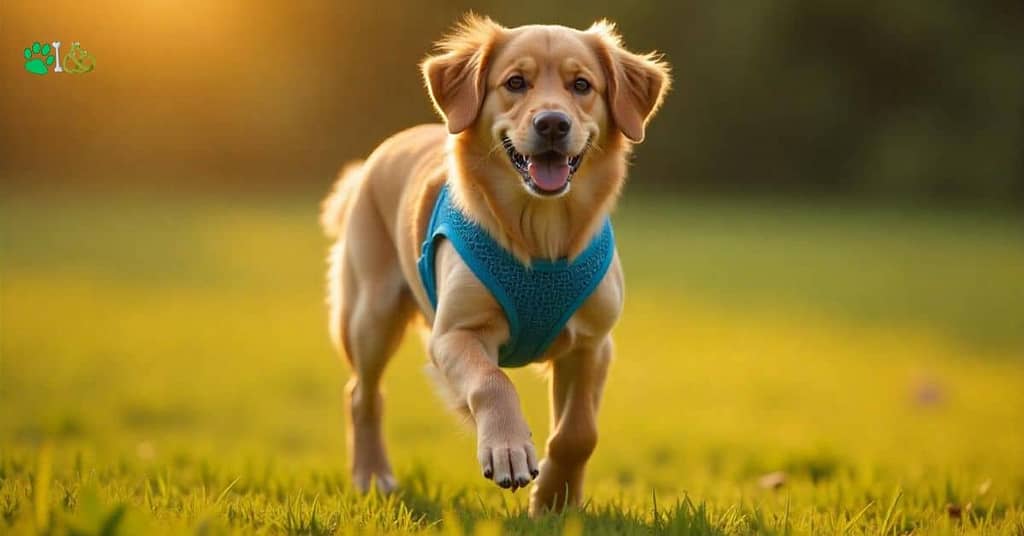You have seen those viral videos, right? The 3D-printed tortoise shells, the custom cat wheelchairs? What started as tech novelties are now changing how we care for pets. I remember my neighbor’s rescue Greyhound, Luna – no store-bought harness fit her deep chest properly. She’d freeze on walks, shoulders pinched. That’s the gap custom harnesses for dogs fill: not just gear, but compassionate problem-solving.
Why customization isn’t just “nice-to-have”:
- Comfort: Ever seen a dog constantly bite at their straps? Chafing isn’t just annoying – it’s painful. A harness rubbing the wrong way can turn a joyful walk into misery.
- Safety: That “Houdini dog” slipping its harness near traffic? Or worse– a collapsed trachea from pressure on the neck? Precision fit saves lives.
- Special Needs: This is where my heart swells. Dogs like tripod pups or seniors with arthritis need gear that adapts to them. Standard harnesses? They often fail these heroes.

What Exactly IS a 3D-Printed Harness? (Spoiler: It’s Not Plastic Straps)
Picture this: Instead of stitching nylon panels, a machine builds a harness layer-by-layer from molten plastic filament – like a super-precise hot glue gun drawing in 3D. The result? A pet harness 3D model becomes a tangible, tail-wagging reality.
How it’s NOT like your old harness:
| Traditional Harness | 3D-Printed Harness |
|---|---|
| Cut from flat fabric | Sculpted to your dog’s curves |
| Rigid straps | Flexible, joint-friendly material |
| S/M/L sizing (often wrong) | Scanned-to-fit precision |
| Made for “average” dogs | Made for YOUR dog |
Real-World Types I have Seen Work Miracles:
- The “Walk Happy” Standard: For quirky-bodied dogs (Dachshunds, I’m looking at you!).
- Mobility Magic: With handles to support wobbly hips– a game-changer for old Labs.
- Tripod Heroes: Dog prosthetic harness designs that redistribute weight so 3-legged pups can run without pain.
- Post-Op Protectors: Shielding stitches after surgery while allowing potty breaks.
It’s not plastic armor. It’s flexible dog harness tech that moves with them.
Why Bother? The Raw Truth About Custom 3D Benefits
Look, I get it – traditional harnesses are cheap and everywhere. But after seeing a Chihuahua with rubbed-raw armpits from a “small” harness? Here’s why custom 3D wins:
- Fit Like a Second Skin
No more gapping or digging. Imagine a harness that follows every rib curve and shoulder blade. That’s custom-fit dog harness magic. For barrel-chested Pugs or skinny Salukis – it finally fits right. - Bye-Bye, Chafing
Traditional straps are like sandpaper on sensitive spots. 3D-printed versions? Smooth, seamless surfaces. Less rubbing = happier skin. (Ask any wrinkly Bulldog owner!) - Feather-Light & Tough as Nails
Materials like TPU feel like rubbery silicone – crazy light but tear-resistant. Bonus? They breathe. No more sweaty, stinky padding. Lightweight pet harness isn’t marketing fluff – it’s real. - Tweak It ‘Til It’s Perfect
Found a pressure point? Scan → adjust design → reprint that piece overnight. No shipping returns or wasted $80 harnesses. - The REAL Game-Changer: Special Needs
This is why I champion this tech. Dog harness for disabled dog isn’t a niche – it’s liberation:- A paralyzed Dachshund standing again with a custom dog mobility harness.
- A tripod Boxer running without limping.
- A dog with severe scars finally wearing gear that doesn’t hurt.
Your Dog’s Digital Tailor: How 3D Printing Actually Works
Let’s demystify the magic. Creating a custom harness feels less like factory work and more like commissioning a bespoke suit – but for your pup. Here’s the real-world process, warts and all:
Step 1: Capturing Your Dog’s Blueprint (The “3D Scan Dog Harness” Start)
Option A: The Tech Route
Got a newer iPhone/iPad? That LiDAR scanner isn’t just for AR games. Apps like Polycam or Scandy Pro can create shockingly accurate 3D scans if your dog holds still for 30 seconds (treats mandatory!).
Pro tip: Scan outdoors for best light.
Option B: Old-School Measuring
No fancy tech? Grab a soft tape measure and notepad. You’ll need:
- Neck circumference (where collar sits)
- Chest girth (behind front legs)
- Back length (base of neck to tail)
- Distance between leg openings
Confession: My first DIY attempt missed the “armpit-to-sternum” depth – result? A harness that rubbed. Measure twice, print once.
Step 2: Designing the Dream Harness (CAD Dog Harness Design)
This is where digital clay gets molded:
- Software: TinkerCAD (free, beginner-friendly) or Fusion 360 (free for hobbyists) are your friends.
- Key Moves: Import your scan/measurements → sculpt contours avoiding bony areas → add ventilation holes → design attachment points for leash rings.
Reality Check: My early designs were bricks. Flexibility zones (thin lattice sections) near shoulders/legs are CRITICAL for movement.
Step 3: Material Matters – TPU vs. PLA Smackdown
| Material | Feels Like | Best For | Watch Out For |
|---|---|---|---|
| TPU (NinjaFlex, Cheetah) | Flexible dog harness parts touching the skin | Flexible dog harness parts touching skin | Stringy during printing – needs direct-drive extruder |
| PLA+ | Stiff plastic | Structural clips/buckles | Brittle in cold weather |
| PETG | Tough water bottle | All-weather outdoor harnesses | Warping if bed isn’t perfectly level |
Vet Insight: “TPU is king for comfort,” says Dr. Lena Torres, DVM. “Avoid PLA near skin – it can splinter if chewed.”
Step 4: Printing, Gluing & The “Oh Crap” Moments
- Print Settings: 20-30% infill (saves material, keeps it light), 0.8-1.2mm walls (durability), SLOW printing speed for TPU (trust me!).
- Post-Processing: Sand sharp edges → wash with soapy water → dry thoroughly.
- Assembly: Use PETG rivets or UV-curing resin to bond parts. Superglue fails with flex!
SAFETY CHECKLIST (Non-Negotiable!):
- Tug-test every strap connection HARD.
- Watch for rubbing during first 10-minute “test drive.”
- Inspect for cracks weekly (especially PLA parts).
Real Dogs, Real Miracles: When Tech Meets Tails
Case Study: Tripod Turbo & 3DPets
Meet Turbo, a Boxer who lost a leg to cancer. Standard harnesses slid sideways, straining his spine. Enter 3DPets.org – a nonprofit using NinjaFlex Edge (a crazy-flexible TPU). Their harness:
- Asymmetric design compensating for a missing limb
- The chest plate distributes weight evenly
- Non-slip silicone grip pads
Owner’s Voice: “First walk without hopping? He peed on a tree for 2 minutes straight. Pure joy.” This isn’t just a dog prosthetic harness – it’s freedom.
Veterinary Revolution: Beyond the Bandage
Dr. Evan Singh (UC Davis Vet Robotics Lab) nails it:
“3D printing lets us create dog rehabilitation harnesses in hours, not weeks. A Dachshund with IVDD needs spinal support? We scan, design lateral bracing overnight, and adjust based on rehab progress. It’s transformative.”
The “Grandpa Max” Effect:
Max, a 14-year-old Lab with arthritis, hated stiff harnesses. His owner printed a hybrid harness: TPU mesh panels (breathable, zero pressure points) + PETG spine support. Result? Walks resumed. Small win? Maybe. Life-changing for Max? Absolutely.
DIY or Cry: Your Garage Workshop Guide
Tools You Can’t Skip:
- Printer: Ender 3 V3 SE ($200) handles TPU okay. Bambu Labs P1P ($600) is the “just works” hero.
- Software: TinkerCAD (free), Fusion 360 (free for makers), Blender (advanced sculpting).
- Misc: Digital calipers ($15), soft measuring tape, emery boards (for sanding).
Finding Your Blueprint:
- Thingiverse: Search “custom dog harness STL” – filter by “remixable” licenses.
- Printables: Look for “parametric” models (adjust sizes via sliders).
Pro Tip: Start with “Buster Harness V2” – modular, well-documented.
Measuring Like a Pro (Avoid My Mistakes):
- Dog Position: Standing naturally, head up.
- Tightness: Two fingers must slide under the tape measure.
- Critical Spot: “Girth depth” (sternum to spine). Miss this = guaranteed chafing.
Printing & Assembly Cheat Sheet:
- TPU Settings:
- Print Speed: 30mm/s MAX
- Retraction: OFF (yes, really)
- Bed Temp: 60°C (glues tick adhesion)
- PLA/PETG Parts: Print vertically for strength.
- Assembly: Bond TPU with Shoe Goo (flexes better than epoxy).
Troubleshooting Tears:
- Problem: Harness slides forward on deep-chested dogs.
Fix: Add a ventral strap connecting chest plate to girth strap.* - Problem: TPU straps stretching over time.
Fix: Print “tensile” orientation (layers parallel to pull direction).* - Problem: Dog hates the “new car smell.”
Fix: Soak in vinegar/water solution pre-use.*
Safety First, Cuddles Second: Keeping That Harness Trustworthy
Fit Checks: The 5-Second Daily Ritual
Slide two fingers flat under every strap. If it’s tight, loosen it. If it’s loose after a shake? Redesign time. Watch for:
- Red marks after removal (rubbing)
- “Saddling” (harness sliding sideways on deep-chested breeds)
- Your dog side-eyeing the harness (they always tell you).
Confession: My Greyhound once got a raw spot because I ignored slight gapping near his sternum. Daily checks save skin.
Cleaning Your 3D Printed Harness (Without Melting It)
- Wipe Down Daily: Damp microfabric cloth + drop of pet-safe soap.
- Deep Clean Monthly:
- TPU/PETG: Soak 15 mins in lukewarm water + vinegar (1:4 ratio)
- PLA: Surface wipe ONLY (water warps it!)
- NEVER: Dishwasher, boiling water, harsh chemicals. That “clean” smell? Toxic residue.
When to Retire Your Masterpiece:
- Cracks/fraying: Especially near buckles (PLA snaps without warning!).
- Stretched straps: If TPU deforms >5% permanently, it’s fatigue city.
- Dog growth/weight change: That puppy harness won’t fit a 60lb adult.
- After 6-12 months: UV light and friction degrade even tough plastics.
Pro Tip: Print replacement parts before failure. Keep spare clips on hand.
The Future’s Barking: Where 3D Printing is Headed
1. Smart Harnesses (Beyond GPS):
- Real-time vitals monitoring: Heart rate/respiration sensors printed into TPU layers.
- Lameness detectors: Gyroscopes alerting you to abnormal gait before limping starts.
- Auto-tightening: Pressure-sensitive straps adjusting during activity.
2. Eco-Warrior Materials:
- Algae-based filaments: Fully biodegradable harnesses (tested by Wageningen University).
- Recycled ocean plastics: Brands like Fishy Filaments turning nets into pet gear.
3. Vet Tech Revolution:
- On-demand printing: Clinics producing dog rehabilitation harnesses during your appointment (UC Davis piloting this).
- Integrated prosthetics: Harness sockets that snap-change limbs for growing pups.
Dr. Torres’ Prediction:
In 5 years, custom 3D-printed supports will be as standard as X-rays. It’s not futurism – it’s cost-effective compassion.
See Also: Gooby Dog Harness: Comfortable and Safe
FAQs on “3D-Printed Custom Dog Harness”
Q: Can I print for ANY dog?
A: Yes – but Great Danes need industrial printers. Size limits = your printer’s bed. Split designs exist!
Q: Is this stuff PET-SAFE?
A: TPU/PETG: Non-toxic when properly cured. PLA: “Food-safe” ≠ chew-proof. If your dog’s a shredder, avoid PLA near teeth.
Q: Does my dog NEED custom?
A: Try this:
Does your dog limp adjusting to harness?
Have scars/unusual proportions?
Escape standard gear?
One “yes” = custom solves it.
Q: Help! I’m stuck!
A: Design: r/3DPetProjects (Reddit)
Printing: Local MakerSpace ($5/hour)
Scanning: Vet clinics with 3D labs
Wrapping Up & Your Toolkit
Why This Matters Beyond Tech:
3D printing turns “impossible fits” into wagging tails. It’s not about gadgets – it’s about dignity for disabled dogs, comfort for seniors, and finally fitting that weird-shaped rescue mutt.
Ready to Try? Start Here:
- For Non-Techies: 3DPets.org (Request a free harness)
- DIY Warriors:
- Thingiverse: Custom Dog Harness Collection
- Buster Harness V3 Tutorial
- Vet Collaboration: Ask your clinic about 3D partnerships



